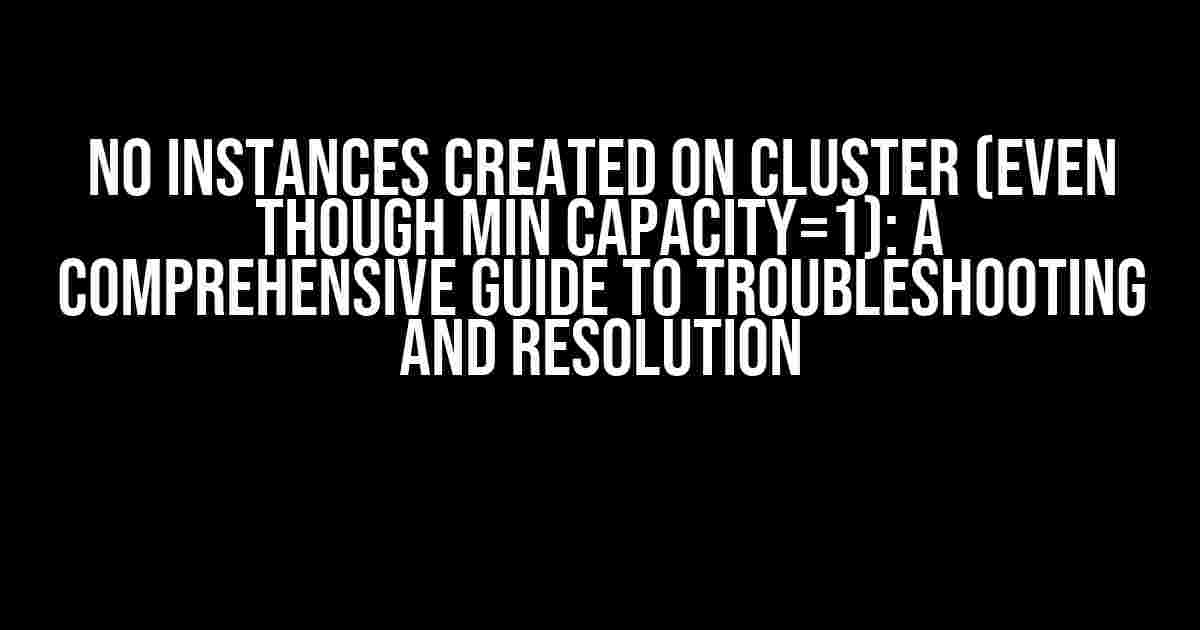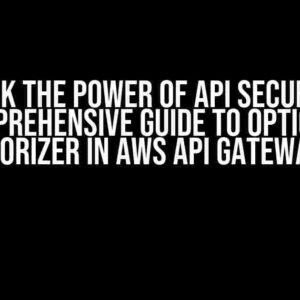Introduction
If you’re reading this article, chances are you’re frustrated and scratching your head, wondering why no instances are being created on your cluster despite setting the minimum capacity to 1. Don’t worry, you’re not alone! This issue is more common than you think, and we’re here to help you troubleshoot and resolve it once and for all.
Understanding the Problem
Before we dive into the solutions, let’s take a step back and understand what’s happening behind the scenes. When you set the minimum capacity to 1, you expect at least one instance to be created on your cluster. However, if the cluster is not creating any instances, it’s likely due to one of the following reasons:
Insufficient resources: The cluster might not have enough resources (e.g., CPU, memory, or disk space) to create a new instance.Configuration issues: The cluster configuration might be preventing instances from being created.Network connectivity problems: Network issues might be blocking the creation of new instances.Permission or access issues: The cluster might not have the necessary permissions or access to create new instances.
Troubleshooting Steps
Now that we’ve identified the possible causes, let’s go through a series of troubleshooting steps to identify and resolve the issue.
Step 1: Check Cluster Resources
Verify that the cluster has sufficient resources to create a new instance. Check the cluster’s resource utilization using the following command:
kubectl top nodesThis command will display the resource utilization for each node in the cluster. Look for any nodes that are heavily utilized or running low on resources.
Step 2: Review Cluster Configuration
Review the cluster configuration to ensure that it’s set up correctly. Check the following:
- Verify that the
minAvailableparameter is set to 1 in the cluster configuration file. - Check that the cluster has enough capacity to create a new instance.
- Ensure that the cluster is not configured to scale down to 0 instances.
Step 3: Inspect Network Connectivity
Verify that the network connectivity between the cluster nodes and the API server is functioning correctly. Run the following command to check the network connectivity:
kubectl get nodes -o yamlThis command will display detailed information about each node in the cluster, including their network connectivity status.
Step 4: Investigate Permission and Access Issues
Check if the cluster has the necessary permissions and access to create new instances. Verify that:
- The cluster service account has the necessary permissions to create new instances.
- The cluster has access to the necessary resources (e.g., images, storage, etc.).
Common Solutions
Based on our troubleshooting steps, here are some common solutions to the “no instances created on cluster” issue:
Solution 1: Increase Cluster Resources
If the cluster lacks sufficient resources, consider increasing the resource allocation or adding more nodes to the cluster. This will provide the necessary capacity to create new instances.
Solution 2: Update Cluster Configuration
If the cluster configuration is incorrect, update the configuration to ensure that the minAvailable parameter is set to 1 and the cluster has sufficient capacity to create new instances.
Solution 3: Resolve Network Connectivity Issues
If network connectivity issues are preventing instance creation, resolve the network issues by:
- Verifying network connectivity between nodes and the API server.
- Checking firewall rules and adjusting them as necessary.
Solution 4: Grant Necessary Permissions and Access
If permission or access issues are preventing instance creation, grant the necessary permissions and access to the cluster service account. This can be done by:
- Updating the cluster service account permissions.
- Ensuring that the cluster has access to the necessary resources.
Conclusion
We’ve covered the common causes, troubleshooting steps, and solutions to the “no instances created on cluster” issue. By following these steps and solutions, you should be able to identify and resolve the issue, ensuring that your cluster is creating instances as expected. Remember to stay calm, be patient, and don’t hesitate to reach out for further assistance if needed.
| Troubleshooting Step | Potential Cause | Solution |
|---|---|---|
| Check Cluster Resources | Insufficient resources | Increase cluster resources |
| Review Cluster Configuration | Configuration issues | Update cluster configuration |
| Inspect Network Connectivity | Network connectivity problems | Resolve network connectivity issues |
| Investigate Permission and Access Issues | Permission or access issues | Grant necessary permissions and access |
Remember, troubleshooting is an iterative process, and it may take some time to identify and resolve the issue. Stay focused, and don’t give up! With persistence and the right guidance, you’ll get your cluster up and running in no time.
Here are 5 Questions and Answers about “No instances created on cluster (even though min capacity=1)” in a creative voice and tone:
Frequently Asked Question
Get the inside scoop on resolving that pesky “No instances created on cluster” issue!
Q1: I’ve set the minimum capacity to 1, so why aren’t any instances being created on my cluster?
Hey there! Make sure you’ve also set the desired capacity to 1 or more. Even with a minimum capacity of 1, if the desired capacity is 0, no instances will be created. Double-check your settings and you should be good to go!
Q2: Are there any specific cluster settings I should be aware of that might be causing this issue?
Yes! Verify that your cluster is enabled and not suspended. Also, ensure that you have sufficient resources (e.g., available IP addresses, sufficient instance types) to launch new instances. If you’re still stuck, review your cluster’s scaling settings and adjustment type to ensure they’re correctly configured.
Q3: Could my instance type be the culprit behind this problem?
Possibly! If your instance type is not available in the chosen Availability Zone, or if it’s not compatible with the cluster’s VPC, no instances will be created. Try selecting a different instance type or Availability Zone to see if that resolves the issue.
Q4: Are there any IAM role or permission issues that might be preventing instance creation?
You’re on the right track! Ensure that the IAM role associated with your cluster has the necessary permissions to launch instances. Specifically, check that the role has the ‘ec2:RunInstances’ permission. If you’re still having trouble, review your IAM policies and update them as needed.
Q5: What if I’ve checked all of these potential causes and still, no instances are being created?
Don’t worry! In this case, it’s likely that there’s a more complex issue at play. Reach out to your cloud provider’s support team for further assistance. They’ll be able to dig deeper and help you identify the root cause of the problem.


